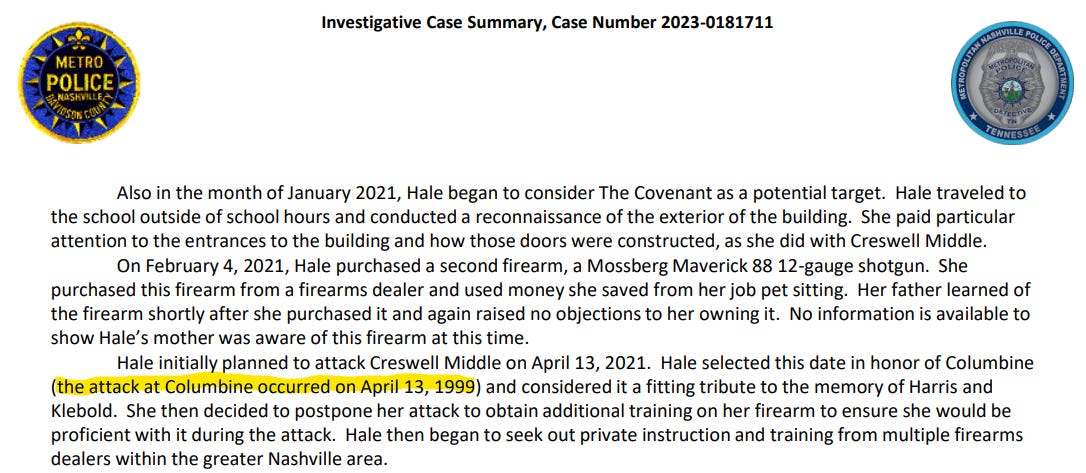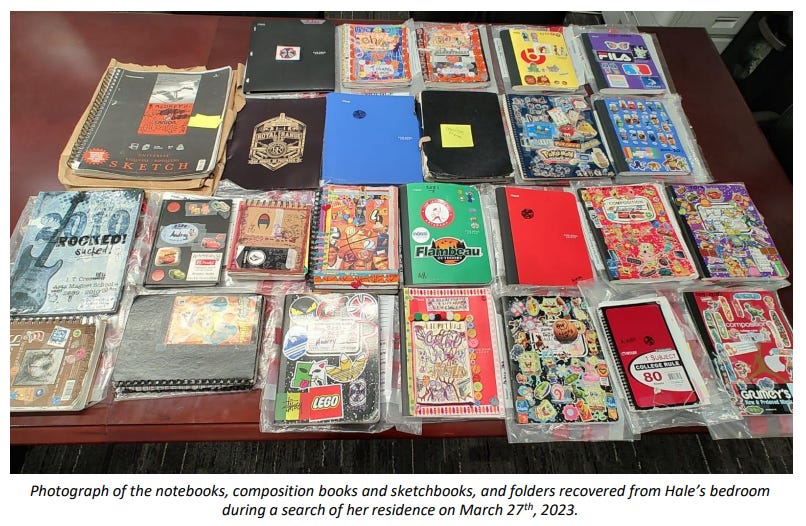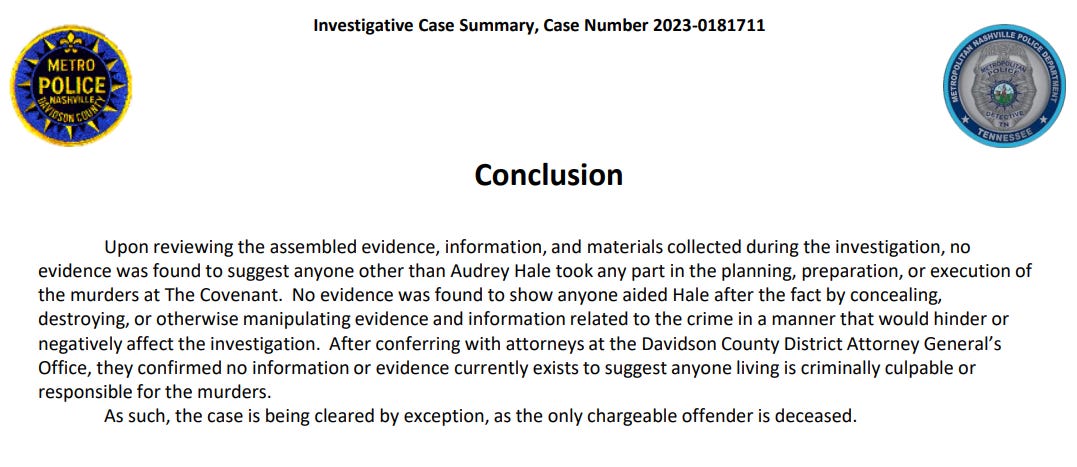Covenant School shooting motives and missed warnings
Timeline, behaviors, motives, and planning from the official report on the Nashville school shooting in March 2023.
School shootings are not random acts of violence. They usually involve months or years of planning. While Hale was older than most school shooters (28-years-old at the time of the attack), her planning started six years earlier. Essentially her entire adult life was centered on becoming a school shooter.
According to the Nashville Police Department’s report published last week, Hale used three criteria in selecting a location for her planned attack:
It had to provide a sense of infamy so she would be remembered.
Targets within the location would likely not put up much of a fight and give her a high likelihood of success (only demographical factor she considered in target selection was it had to involve children).
She had to have a connection to the location.
Her planning didn’t involve targeting specific individuals within any location. She became obsessed with school shooters because they “were a topic that immediately gained society’s undivided attention and inherently shocked the conscience” and “violent deaths of younger children quickly garnered attention and were remembered by society well after the fact” (page 38).
While Elon Musk, Trump Jr., and conservative media have repeatedly made false claims that the Nashville school shooting was based on Hale being transgender and there is an “epidemic of transgender mass shooters”, the Nashville Police Department refutes that claim:
She began to use the name “Aiden Williams” in the years prior to her death and used male pronouns on her social media and networking accounts. Nothing has been found to suggest she initiated or was undergoing a transition at the time of her death, including medical documentation. During her autopsy following her death, it was determined she was biologically female. (page 15)
If you missed it, my first article about this new police report analyzes the timeline and details of the attack: Official report on the Covenant School shooting in Nashville
Planning started 6 years before her attack
Six years before opening fire inside the Covenant School in Nashville, Hale started researching school shootings. By the time the Parkland school shooting happened in 2018, Hale already had a written plan and was deeply obsessed with the Columbine shooters. In 2019, she was writing a list of her goals as a school shooter including the type of firearms training she would need to achieve them.
In 2020, she started purchasing firearms, making detailed diagrams of the school, and started recording her own VHS versions of the “Columbine Bedroom Tapes” (note: more commonly known as “Basement Tapes”).
She originally planned to attack Creswell Middle School in Nashville which is a public school she also attended. She took photos of the building and drew maps of the campus. In 2021, she shifted focus to the Covenant School while continuing secondary planning for other targets including the Green Hills Mall and Opry Mills Mall.
Two years before the attack, Hale scheduled a tour of the Covenant School campus and photographed the inside of the building. In 2022, she decided on The Covenant School as her “Plan A” target with Opry Mills Mall as her “Plan B”, and the Belmont University campus as her “Plan C”.
Motive
Hale was depressed, suicidal, and diagnosed with major depressive disorder, dysthymic disorder, generalized anxiety disorder, and social phobias. Her family reported that from 5th-8th grade she was bullied and had few friends. She was first treated for contemplating suicide in 9th grade.
Most school shooters and mass shooters are actively suicidal, and they see a violent public suicide as their only option. Hale wrote that she saw herself as “the true victim” in the attack.
Even though numerous disappointments in relationships, career aspirations, and independence fueled her depression, and even though this depression made her highly suicidal, this doesn’t explain the attack. As Hale wrote on several occasions, if suicide was her goal then she would have simply killed herself. Throughout the writings and videos, Hale frequently commented that her death needed to matter and be remembered.
Throughout her life, Hale experienced loneliness and disappointment. She felt abandoned and ignored by those she longed to befriend and engage with romantically, which angered her more than anything else. She believed that by simply committing suicide, she would be quickly forgotten and not even worthy of a footnote in history. She craved the notoriety Harris and Klebold attained following Columbine. This can be seen clearly with the frequent references in her writings and videos of how they became “gods” following their attack. This led to a deep desire on her part to become a “god” like them. (page 37)
Overt Warnings
As Hale was receiving mental health treatment, there were clear warning signs of a school shooting plot in the works. In June 2021, Hale’s mother found a copy of the Columbine Diaries (available on Amazon).
This prompted a meeting between Hale, her parents, and her therapist regarding Hale’s firearms. At this point, it came to light how Hale had been experiencing homicidal fantasies towards her father. Her therapist and parents convinced Hale to surrender her firearms to her parents, who would then store the firearms at a safe location. (page 27)
There is an error in the Nashville police report. The shooting at Columbine High school took place on April 20, 1999. It was planned for April 19 on the anniversary of the OKC bombing. Due to a delay in getting one of the guns, the attack took place a day later than it was planned. Hale’s plot to attack Creswell Middle on 4/13/21 wouldn’t be on the Columbine anniversary date.
Regardless of the date the attack was planned for, recording her own versions of the Basement Tapes and glorifying the Columbine shooters in her writings shows that Columbine had a significant influence on her desire to become a school shooter. This isn’t a surprise because Columbine is directly linked to dozens of school shooters.
Firearms training
Many school shootings end very quickly because the teenage assailants are not familiar with the firearms they are using (e.g., their gun jams and they don’t know how to clear the round). Hale was very familiar with her guns and fired 152 bullets inside the school. The attack could have been much worse because she still had 272 additional rounds with her that were loaded in magazines.
She was proficient in using firearms because she wrote about the need for training and practice in her journals.
Between January and May 2022, Hale began to attend formal firearms training classes at Royal Range USA. Based on the information gathered during the investigation, the classes she participated in were designed to teach basic marksmanship and safety techniques to new shooters, as well as how to use the firearm for the purpose of self-defense. (page 28)
Like other school shooters and mass shooters, she painted symbols and messages on her firearms. Guns with inscriptions are symbols of violent ideology rather than tools for utility. School shooters and mass shooters frequently write messages on their weapons. A fixation on guns as a symbol of identity and power is a red flag for mass violence. (Listen to Dr. Tahir Rahman explain the danger when guns become symbols of identity, power, and hate.)
She also researched websites devoted to marksmanship and downloaded shooting drills she believed would help her become more proficient and deadly during a mass shooting. She continued to shop for an AR pistol during this time and remarked how she took every opportunity to rent and try out different AR pistols to decide which one she wanted. (page 28)
Suicide and Desire to Die
Two months before the attack, the report states that Hale began seeking alternate targets in case she felt compelled to commit an attack when The Covenant School was closed. Hale based the need for an alternate target due to her increasing depression, which she worried would drive her to suicide before she was ready to commit an attack.
This is strikingly similar to a teen who planned a school shooting in Bend, OR in 2022 but instead opened fire inside a Safeway grocery store. He went to the grocery store near his house because the school was closed for summer break until September 8th and he couldn’t wait another week. Like Hale, the 20-year-old perpetrator was also obsessed with Columbine.
The clothing that school shooters wear is highly symbolic (see: Nashville school shooter mimicked photos posted by other teenage killers).
Hale created a t-shirt with handwritten phrases and her “Dark Abyss” logo printed on the front that she intended to wear during the trial (this shirt was very similar to the one she intended to wear during the attack). Believing she would likely not receive the death penalty for committing a mass murder, she held out hope that one of the other inmates would kill her once she was taken into custody. (page 28)
In the final six months leading up to the attack, she was still receiving mental health treatment.
During the fall of 2022, Hale became increasingly paranoid. She was constantly worried about being discovered by her parents or therapist. She was worried they would discover her plans and contact law enforcement, which would result in her being involuntarily hospitalized and her firearms taken from her. She documented occasions where she believed she was almost caught by her mother and chided herself about being more careful.
Due to this paranoia and her increasing desire to die during a mass attack, Hale created another “emergency plan,” which involved her killing her parents to prevent them from raising an alarm. In this contingency, she decided following their deaths she would need to quickly travel to one of her “emergency” targets and commit a mass killing, even though neither location were her ideal target. (page 29)
Hale wrote detailed accounts of her feelings, mental state, and planning in a dozen notebooks that were found in her bedroom.
At times, these conditions rose to the surface, despite Hale’s best efforts to control her inner turmoil. This led to situations where her parents and therapists sought more intensive treatments to manage her assorted mental health disorders, including partial hospitalization programs. These methods ultimately failed to successfully treat Hale, though it can be said this was due to Hale herself not wanting to be treated. Instead, these attempts led Hale to becoming very paranoid, more secretive, and to further self-isolate herself from the world. This also led to Hale becoming more manipulative towards her parents and therapists as time progressed. Hale’s paranoia grew to the point where she seriously considered and planned to kill her mother to prevent her attack plans from being foiled, despite her strong emotional attachment to her mother.
Despite all her assorted mental health disorders, Hale was certainly sane. She was capable of adjusting her plans as needed, manipulating others into seeing her as meek and nonthreatening, and fully understood her attack was not only criminal but morally reprehensible. (Page 36)
Hale’s Goal
For six years, Hale idolized the Columbine shooters, planned to be a school shooter, trained for the attack, and wanted to die inside the school.
She expected there would be books and documentaries dedicated to her and the attack, how her bedroom would become a museum dedicated to her memory, and expected her firearms, artwork, and writings to be prominently displayed in museums worldwide. She wanted her mental health to be a prominent topic of discussion and debate. Most disturbingly, she wanted the things she left behind to be shared with the world so she could inspire and teach others who were “mentally disordered” like her to plan and commit an attack of their own. (page 37)
Her desire for others to follow her is different from the highly individual plans of other school shooters that I’ve studied. For example, the CVPA High school shooter’s manifesto is all about his personal feelings and desire to die. His death is the final act and he doesn’t write about influencing anyone else (see: Warning: School shooter's manifesto shows failures across American society).
She wanted her mental health to be a prominent topic of discussion and debate. Most disturbingly, she wanted the things she left behind to be shared with the world so she could inspire and teach others who were “mentally disordered” like her to plan and commit an attack of their own. (page 37)
Two years after the attack, the case is officially closed because Hale acted alone and she died.
That’s where the story ends in Nashville. Fortunately, we can use this information as a reminder that there will be opportunities to stop the next school shooting. Hale’s plot wasn’t a secret and there were plenty of chances to stop her before she walked into the Covenant School with three guns.
In the two years since the school shooting, there were two legislative cycles with bills proposed in Tennessee to allow police to seize firearms from someone who wants to harm themselves or others. Hale’s family tried to keep her from buying guns, but there was no legal framework to aid them.
Instead of passing a red flag law, Tennessee took the opposite path with a state law the prohibits any local red flag laws or enforcement of protection orders by police. And without any meaningful changes to allow for prevention, nobody was surprised when there was another preventable planned attack at high school in Nashville this year.
This depressing article comes to a depressing end because as long as state laws keep enabling school shooters and preventing their families from preventing the attacks, there will probably be another school shooting later this year.
David Riedman is the creator of the K-12 School Shooting Database, Chief Data Officer at a global risk management firm, and a tenure-track professor. Listen to my weekly podcast—Back to School Shootings—or my recent interviews on Freakonomics Radio, New England Journal of Medicine, and my article on CNN about AI and school security.














